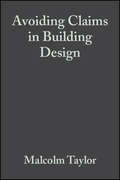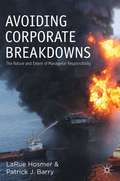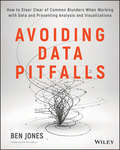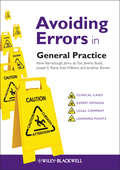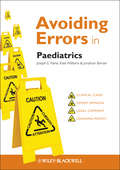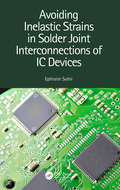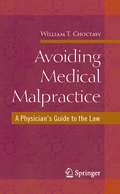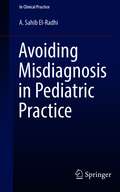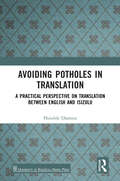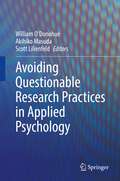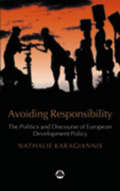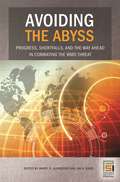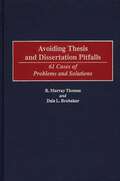- Table View
- List View
Avoiding Attack: The Evolutionary Ecology of Crypsis, Aposematism, and Mimicry
by Graeme D. Ruxton William L. Allen Thomas N. Sherratt Michael P. SpeedAvoiding Attack discusses the diversity of mechanisms by which prey avoid predator attacks and explores how such defensive mechanisms have evolved through natural selection. It considers how potential prey avoid detection, how they make themselves unprofitable to attack, how they communicate this status, and how other species have exploited these signals. Using carefully selected examples of camouflage, mimicry, and warning signals drawn from a wide range of species and ecosystems, the authors summarise the latest research into these fascinating adaptations, developing mathematical models where appropriate and making recommendations for future study. This second edition has been extensively rewritten, particularly in the application of modern genetic research techniques which have transformed our recent understanding of adaptations in evolutionary genomics and phylogenetics. The book also employs a more integrated and systematic approach, ensuring that each chapter has a broader focus on the evolutionary and ecological consequences of anti-predator adaptation. The field has grown and developed considerably over the last decade with an explosion of new research literature, making this new edition timely.
Avoiding Carbon Apocalypse Through Alternative Energy: Life After Fossil Fuels
by John LowryThis important book lays bare the dangers of global warming caused by carbon dioxide emissions stemming from fossil fuel use, and proposes pathways toward mitigation. A discussion of the current main uses of fossil fuels acts as a basis for presenting viable, economically sound alternatives. The author outlines a clear, practical strategy for establishing a carbon-free future by deploying proven policy structures and technologies that are already commercially available.
Avoiding Claims in Building Design: Risk Management in Practice
by Malcolm TaylorThe chance of being claimed against is now a major risk factor for every building designer, engineer, quantity surveyor and project manager. Apart from the cases that go to court, many other claims are settled before they reach that stage. The cost of insurance to meet claims is now a substantial component of every practice's overheads. Sensible risk management can identify the potential sources of claims, reduce their likelihood, warn of impending trouble and control how the claim is to be defended. This book explains how to plan a risk management strategy and suggests techniques that can supplement the practice's existing management procedures without imposing unnecessary bureaucracy. It attaches as much importance to the interaction of risk between members of the design team as to the risk profile of the practice itself. The first part defines risk and its origins, discusses how risk can arise in the various professions and types of practice, and how it interacts between the professions, compares quality assurance with risk management, and advises on the relations between the practice, its insurers and its lawyers. It concludes with advice on how to create a risk strategy and system for the office. The second part is devoted to techniques and covers: setting up the appointment; creation of the team; managing the project; the risks of CDM; the complications of procurement; and drafting, awarding and administering the building contract. Risk implications of the major contract forms are discussed in detail. It concludes with advice on the handling of claims. The book contains references to a number of legal cases to illustrate the risks discussed. It is recommended reading not only for the individual professions (architect, engineer, QS, project manger), but for all of them collectively in understanding how the risk of one profession can become the risk of any of his fellow team members.
Avoiding Corporate Breakdowns: The Nature and Extent of Managerial Responsibility
by L. Hosmer P. BarryAvoiding Corporate Breakdowns focuses on prescribing a preventative strategy for managerial actors who face economic, social and environmental disasters. Prevention is basically simple, but it will require a considerable broadening in both the nature and the extent of managerial responsibility.
Avoiding Data Pitfalls: How to Steer Clear of Common Blunders When Working with Data and Presenting Analysis and Visualizations
by Ben JonesAvoid data blunders and create truly useful visualizations Avoiding Data Pitfalls is a reputation-saving handbook for those who work with data, designed to help you avoid the all-too-common blunders that occur in data analysis, visualization, and presentation. Plenty of data tools exist, along with plenty of books that tell you how to use them—but unless you truly understand how to work with data, each of these tools can ultimately mislead and cause costly mistakes. This book walks you step by step through the full data visualization process, from calculation and analysis through accurate, useful presentation. Common blunders are explored in depth to show you how they arise, how they have become so common, and how you can avoid them from the outset. Then and only then can you take advantage of the wealth of tools that are out there—in the hands of someone who knows what they're doing, the right tools can cut down on the time, labor, and myriad decisions that go into each and every data presentation. Workers in almost every industry are now commonly expected to effectively analyze and present data, even with little or no formal training. There are many pitfalls—some might say chasms—in the process, and no one wants to be the source of a data error that costs money or even lives. This book provides a full walk-through of the process to help you ensure a truly useful result. Delve into the "data-reality gap" that grows with our dependence on data Learn how the right tools can streamline the visualization process Avoid common mistakes in data analysis, visualization, and presentation Create and present clear, accurate, effective data visualizations To err is human, but in today's data-driven world, the stakes can be high and the mistakes costly. Don't rely on "catching" mistakes, avoid them from the outset with the expert instruction in Avoiding Data Pitfalls.
Avoiding Data Pitfalls: How to Steer Clear of Common Blunders When Working with Data and Presenting Analysis and Visualizations
by Ben JonesAvoid data blunders and create truly useful visualizations Avoiding Data Pitfalls is a reputation-saving handbook for those who work with data, designed to help you avoid the all-too-common blunders that occur in data analysis, visualization, and presentation. Plenty of data tools exist, along with plenty of books that tell you how to use them—but unless you truly understand how to work with data, each of these tools can ultimately mislead and cause costly mistakes. This book walks you step by step through the full data visualization process, from calculation and analysis through accurate, useful presentation. Common blunders are explored in depth to show you how they arise, how they have become so common, and how you can avoid them from the outset. Then and only then can you take advantage of the wealth of tools that are out there—in the hands of someone who knows what they're doing, the right tools can cut down on the time, labor, and myriad decisions that go into each and every data presentation. Workers in almost every industry are now commonly expected to effectively analyze and present data, even with little or no formal training. There are many pitfalls—some might say chasms—in the process, and no one wants to be the source of a data error that costs money or even lives. This book provides a full walk-through of the process to help you ensure a truly useful result. Delve into the "data-reality gap" that grows with our dependence on data Learn how the right tools can streamline the visualization process Avoid common mistakes in data analysis, visualization, and presentation Create and present clear, accurate, effective data visualizations To err is human, but in today's data-driven world, the stakes can be high and the mistakes costly. Don't rely on "catching" mistakes, avoid them from the outset with the expert instruction in Avoiding Data Pitfalls.
Avoiding Errors in Adult Medicine (AVE - Avoiding Errors)
by Ian Reckless D. John Reynolds Sally Newman Joseph E. Raine Kate Williams Jonathan BonserSome of the most important and best lessons in a doctor’s career are learnt from mistakes. However, an awareness of the common causes of medical errors and developing positive behaviours can reduce the risk of mistakes and litigation. Written for junior medical staff and consultants, and unlike any other clinical management title available, Avoiding Errors in Adult Medicine identifies and explains the most common errors likely to occur in an adult medicine setting - so that you won’t make them. The first section in this brand new guide discusses the causes of errors in adult medicine. The second and largest section consists of case scenarios and includes expert and legal comment as well as clinical teaching points and strategies to help you engage in safer practice throughout your career. The final section discusses how to deal with complaints and the subsequent potential medico-legal consequences, helping to reduce your anxiety when dealing with the consequences of an error. Invaluable during the Foundation Years, Specialty Training and for Consultants, Avoiding Errors in Adult Medicine is the perfect guide to help tackle the professional and emotional challenges of life as a physician.
Avoiding Errors in General Practice (AVE - Avoiding Errors)
by Kevin Barraclough Jenny du Toit Jeremy Budd Joseph E. Raine Kate Williams Jonathan BonserSome of the most important and best lessons in a doctor’s career are learnt from mistakes. However, an awareness of the common causes of medical errors and developing positive behaviours can reduce the risk of mistakes and litigation. Written for Foundation Year doctors, trainees and general practitioners, and unlike any other clinical management title available, Avoiding Errors in General Practice identifies and explains the most common errors likely to occur in an outpatient setting - so that you won’t make them. The first section in this brand new guide discusses the causes of errors in general practice. The second and largest section consists of case scenarios and includes expert and legal comment as well as clinical teaching points and strategies to help you engage in safer practice throughout your career. The final section discusses how to deal with complaints and the subsequent potential medico-legal consequences, helping to reduce your anxiety when dealing with the consequences of an error. Invaluable during the Foundation Years, Specialty Training and for Consultants, Avoiding Errors in General Practice is the perfect guide to help tackle the professional and emotional challenges of life as a GP.
Avoiding Errors in General Practice (AVE - Avoiding Errors)
by Kevin Barraclough Jenny du Toit Jeremy Budd Joseph E. Raine Kate Williams Jonathan BonserSome of the most important and best lessons in a doctor’s career are learnt from mistakes. However, an awareness of the common causes of medical errors and developing positive behaviours can reduce the risk of mistakes and litigation. Written for Foundation Year doctors, trainees and general practitioners, and unlike any other clinical management title available, Avoiding Errors in General Practice identifies and explains the most common errors likely to occur in an outpatient setting - so that you won’t make them. The first section in this brand new guide discusses the causes of errors in general practice. The second and largest section consists of case scenarios and includes expert and legal comment as well as clinical teaching points and strategies to help you engage in safer practice throughout your career. The final section discusses how to deal with complaints and the subsequent potential medico-legal consequences, helping to reduce your anxiety when dealing with the consequences of an error. Invaluable during the Foundation Years, Specialty Training and for Consultants, Avoiding Errors in General Practice is the perfect guide to help tackle the professional and emotional challenges of life as a GP.
Avoiding Errors in Paediatrics (AVE - Avoiding Errors)
by Joseph E. Raine Kate Williams Jonathan BonserSome of the most important and best lessons in a doctor’s career are learnt from mistakes. However, an awareness of the common causes of medical errors and developing positive behaviours can reduce the risk of mistakes and litigation. Written for junior paediatric staff and consultants, and unlike any other paediatric clinical management title available, Avoiding Errors in Paediatrics identifies and explains the most common errors likely to occur in a paediatric setting - so that you won’t make them. The first section in this brand new guide discusses the causes of errors in paediatrics. The second and largest section consists of case scenarios and includes expert and legal comment as well as clinical teaching points and strategies to help you engage in safer practice throughout your career. The final section discusses how to deal with complaints and the subsequent potential medico-legal consequences, helping to reduce your anxiety when dealing with the consequences of an error. Invaluable during the Foundation Years, Specialty Training and for Consultants, Avoiding Errors in Paediatrics is the perfect guide to help tackle the professional and emotional challenges of life as a paediatrician.
Avoiding Errors in Paediatrics (AVE - Avoiding Errors)
by Joseph E. Raine Kate Williams Jonathan BonserSome of the most important and best lessons in a doctor’s career are learnt from mistakes. However, an awareness of the common causes of medical errors and developing positive behaviours can reduce the risk of mistakes and litigation. Written for junior paediatric staff and consultants, and unlike any other paediatric clinical management title available, Avoiding Errors in Paediatrics identifies and explains the most common errors likely to occur in a paediatric setting - so that you won’t make them. The first section in this brand new guide discusses the causes of errors in paediatrics. The second and largest section consists of case scenarios and includes expert and legal comment as well as clinical teaching points and strategies to help you engage in safer practice throughout your career. The final section discusses how to deal with complaints and the subsequent potential medico-legal consequences, helping to reduce your anxiety when dealing with the consequences of an error. Invaluable during the Foundation Years, Specialty Training and for Consultants, Avoiding Errors in Paediatrics is the perfect guide to help tackle the professional and emotional challenges of life as a paediatrician.
Avoiding Inelastic Strains in Solder Joint Interconnections of IC Devices
by Ephraim SuhirAvoiding Inelastic Strains in Solder Joint Interconnections of IC Devices addresses analytical (mathematical) modeling approaches aimed at understanding the underlying physics and mechanics of the behavior and performance of solder materials and solder joint interconnections of IC devices. The emphasis is on design for reliability, including probabilistic predictions of the solder lifetime. Describes how to use the developed methods of analytical predictive modeling to minimize thermal stresses and strains in solder joint of IC devices Shows how to build the preprocessing models in finite-element analyses (FEA) by comparing the FEA and analytical data Covers how to design the most effective test vehicles for testing solder joints Details how to design and organize, in addition to or sometimes even instead of highly accelerated life tests (HALT), highly focused and highly cost-effective failure oriented accelerated testing (FOAT) to understand the physic of failure of solder joint interconnections Outlines how to convert the low cycle fatigue conditions into elastic fatigue conditions and to assess the fatigue lifetime in such cases Illustrates ways to replace time- and labor-consuming, expensive, and possibly misleading temperature cycling tests with simpler and physically meaningful accelerated tests This book is aimed towards professionals in electronic and photonic packaging, electronic and optical materials, materials engineering, and mechanical design.
Avoiding Medical Malpractice: A Physician's Guide to the Law
by William ChoctawWritten by an MD/JD, this book offers a unique perspective on medical-legal issues surrounding daily clinical practice. It covers all the essentials and tells the inside secrets of how to avoid cases that cost the medical community millions each year. Readers will learn basic law and the ways laws are interpreted. In addition, the book focuses on the law-medicine-politics triangle and its effect on physicians, the impact of — and issues related to — diversity in medical malpractice, and other essential topics. Physicians who better understand malpractice laws are better clinical decision makers who feel more confident in their ability as doctors.
Avoiding Misdiagnosis in Pediatric Practice (In Clinical Practice)
by A. Sahib El-RadhiThis book discusses the most common symptoms in pediatrics. It is based on best available scientific evidence and up-to-date information. The book also discusses a range of common conditions associated with bacterial and viral infections of the oro-nasal, eye, chest, abdominal and genito-urinary regions. The book helps the clinician to distinguish symptoms andsigns of pediatric diseases to avoid diagnostic errors. Each chapter starts with a list of core messages, and includes tables and figures to focus on the subjects under discussion. The whole text is written in reader-friendly manner. The book is of interest to general pediatricians and doctors in primary care. It is also of interest to students, nurses and other professionals who look after children.
Avoiding Potholes in Translation: A Practical Perspective on Translation between English and isiZulu
by Phindile DlaminiThis book is a comprehensive introduction to translation studies between English and isiZulu. It incorporates crucial concepts for understanding the basics of translation within a South African language context and lays a foundation for further studies in translation. The book's content coverage, while broad, is also in-depth, and it skillfully integrates examples from varied types of texts. The practical and accessible style makes it both engaging and informative. The diverse examples illustrate not only the technicalities of translation as a process, but the vivid dynamics brought about by the fact that the languages involved in the translation process belong to different language families. The use of these examples for almost every aspect of translation explained makes this book unique and valuable to translation scholars and practitioners alike. Even though the book uses cases from the isiZulu language, it is an applicable reference for translation scholars and practitioners working with different indigenous languages of South Africa. Print edition not for sale in Sub Saharan Africa.
Avoiding Potholes in Translation: A Practical Perspective on Translation between English and isiZulu
by Phindile DlaminiThis book is a comprehensive introduction to translation studies between English and isiZulu. It incorporates crucial concepts for understanding the basics of translation within a South African language context and lays a foundation for further studies in translation. The book's content coverage, while broad, is also in-depth, and it skillfully integrates examples from varied types of texts. The practical and accessible style makes it both engaging and informative. The diverse examples illustrate not only the technicalities of translation as a process, but the vivid dynamics brought about by the fact that the languages involved in the translation process belong to different language families. The use of these examples for almost every aspect of translation explained makes this book unique and valuable to translation scholars and practitioners alike. Even though the book uses cases from the isiZulu language, it is an applicable reference for translation scholars and practitioners working with different indigenous languages of South Africa. Print edition not for sale in Sub Saharan Africa.
Avoiding Questionable Research Practices in Applied Psychology
by William O’Donohue Akihiko Masuda Scott LilienfeldThis authoritative volume presents a detailed analysis of the replication crisis and the use of questionable research practices (QRPs) in psychology, as well as recommended practices for combatting these problems. Ultimately, the book aims to provide a comprehensive, current, and accessible account of the adverse effects of QRPs.The replication crisis in psychology and allied fields has exposed critical flaws in the standard views of research methods, which allow for extensive flexibility in data analysis by investigators and permit the widespread use of QRPs. Chapters examine the intentional use of QRPs such as data fabrication and falsification, along with subtler, unintentional practices such as p-hacking and HARKING (hypothesizing after results are known). Drawing on the growing awareness of these problems, contributors also highlight potential strategies to detect QRPs and minimize their negative impact through open data practices, preregistration of hypotheses and analyses, and adversarial collaborations, in which investigators holding opposing positions on a scientific issue agree to work together on a study in an effort to counteract their respective biases. Among the topics covered:History of controversies in statistics and replicationEmbracing intellectual humility while designing researchConfirmatory vs. exploratory analysesPublication bias and negative resultsPromoting honest and transparent report writingAvoiding Questionable Research Practices in Applied Psychology provides a deeper understanding of how QRPs impede the reliability and trustworthiness of findings in psychology and the social sciences. It will be a practical, useful resource for students and instructors in graduate and advanced undergraduate level research methods classes, along with psychological researchers interested in improving their own research.
Avoiding Responsibility: The Politics and Discourse of European Development Policy
by Nathalie KaragiannisPost-colonial European politics have undergone profound changes. Constructing an intellectual history of European development discourse, this book brings together post-structuralist and critical approaches to understanding development. *BR**BR*Nathalie Karagiannis analyses three key terms of European development discourse: 'responsibility', 'efficiency' and 'giving'. Situating these terms in a concrete history of European post-colonial politics, the author shows how European policy has shifted from accepting responsibility for colonialism - constructed as it is on the paternalistic model of the gift - to a more amnesiac politics in which post-colonial countries are responsible for their own fate.
Avoiding Static Ignition Hazards in Chemical Operations: A CCPS Concept Book (A CCPS Concept Book #20)
by Laurence G. BrittonWritten by Laurence Britton, who has over 20 years' experience in the fields of static ignition and process fire and explosion hazards research, this resource addresses an area not extensively covered in process safety standards or literature: understanding and reducing potential hazards associated with static electricity. The book covers the nature of static electricity, characteristics and effective energies of different static resources, techniques for evaluating static electricity hazards, general bonding, grounding, and other techniques used to control static or prevent ignition, gases and liquids, powders and hybrid mixtures.
Avoiding the Abyss: Progress, Shortfalls, and the Way Ahead in Combating the WMD Threat (Praeger Security International)
by Barry R. Schneider Jim A. DavisIn December 1993, Secretary of Defense Les Aspin announced the Counterproliferation Initiative, a response to President Clinton's assertion that if we do not stem the proliferation of the world's deadliest weapons, no democracy can feel secure. This timely book brings together contributions from a wide range of experts to help readers understand how far the nation has come since then—and what still needs to happen.Insightful essays examine: arms control treaty programs; export control regimes; interdiction; diplomatic/economic/political persuasion and sanctions; deterrence; counterforce; active and passive defense; and consequence management. Many positive changes have occurred since 1993. Regime changes in Iraq and South Africa have removed some WMD proliferation threats. Saddam Hussein has been overthrown, and a new Iraq is beginning to emerge. South Africa's clandestine WMD program has apparently ended. Libya announced it has given up its efforts to have active WMD programs. The Taliban and al Qaeda have been routed in Afghanistan, probably delaying efforts to develop or buy WMD.Yet, states continue to develop and export WMD and/or their delivery systems. As many as 30 states are still believed to have either a nuclear, biological, or chemical weapons program. Some have all three. India and Pakistan have acknowledged programs. Abdul Qadeer Khan, the scientist who directed the Pakistani A-bomb program, has admitted selling nuclear weapons designs, and nuclear enrichment equipment to Libya, Iran, and North Korea. His colleagues have held discussions with al Qaeda representatives. Ayman Al-Zawahiri, number two in the al Qaeda chain of command, claims that the terrorist organization has several suitcase A-bombs from the Former Soviet Union. It appears clear to many that Iran has a desire to develop nuclear weapons. Syria still has a chemical weapons program. North Korea's WMD profile has escalated.As Avoiding the Abyss so convincingly demonstrates, much has been accomplished since the Counterproliferation Initiative was launched-but much work still lies ahead. It is an important story for every American.
Avoiding the Dark: Essays on Race and the Forging of National Culture in Modern Brazil (Routledge Revivals)
by Darien J. DavisFirst published in 1999. This work examines the processes by which Brazilian nationalists forged and propagated an all-inclusive national identity, which attempted to promote racial harmony in the first four decades of the twentieth century. Specific emphasis is given to the rising patriotic feelings under the administration of President Getulio Vargas, which culminated in the creation of Estado Novo in 1937. Vargas’ generation succeeded in encouraging Brazilians to identify with ‘the nation’ above other possible communities, such as radical, ethnic or regional ones. In the process, nationalists created enduring national myths and symbols which successfully marginalised racial consciousness for the rest of the twentieth century.
Avoiding the Dark: Essays on Race and the Forging of National Culture in Modern Brazil (Routledge Revivals)
by Darien J. DavisFirst published in 1999. This work examines the processes by which Brazilian nationalists forged and propagated an all-inclusive national identity, which attempted to promote racial harmony in the first four decades of the twentieth century. Specific emphasis is given to the rising patriotic feelings under the administration of President Getulio Vargas, which culminated in the creation of Estado Novo in 1937. Vargas’ generation succeeded in encouraging Brazilians to identify with ‘the nation’ above other possible communities, such as radical, ethnic or regional ones. In the process, nationalists created enduring national myths and symbols which successfully marginalised racial consciousness for the rest of the twentieth century.
Avoiding Thesis and Dissertation Pitfalls: 61 Cases of Problems and Solutions (Non-ser.)
by R. Murray Thomas Dale L. BrubakerBeing aware of thesis and dissertation pitfalls can help the graduate student make efficient use of resources available to him or her and bring precision to research and writing of that important project. The authors present 61 cases cast as an envisioned conversation between a student and a professor whom the student consults about a problem.The cases are presented within ten chapters that proceed through a sequence of typical stages in the production of a thesis or dissertation. Chapter titles include Choosing and Defining a Research Topic, Searching the Professional Literature, Developing a Proposal, Getting Help, Devising Data-Collection Procedures, Organizing the Collected Information, Interpreting the Results, Writing the Report, Defending the Finished Product, and Publishing the Study.
Avoiding Treatment Failures in the Anxiety Disorders (Series in Anxiety and Related Disorders)
by Michael Otto Stefan HofmannExtensive studies have shown cognitive-behavioral therapy to be highly effective in treating anxiety disorders, improving patients’ social functioning, job performance, and quality of life. Yet every CBT clinician faces some amount of client resistance, whether in the form of “This won’t work”, “I’m too depressed”, or even “You can’t make me!” Avoiding Treatment Failures in the Anxiety Disorders analyzes the challenges presented by non-compliance, and provides disorder- and population-specific guidance in addressing the impasses and removing the obstacles that derail therapy. Making use of extensive clinical expertise and current empirical findings, expert contributors offer cutting-edge understanding of the causes of treatment complications—and innovative strategies for their resolution—in key areas, including: The therapeutic alliance The full range of anxiety disorders (i.e., panic, PTSD, GAD) Comorbidity issues (i.e., depression, personality disorders, eating disorders, substance abuse, and chronic medical illness) Combined CBT/pharmacological treatment Ethnic, cultural, and religious factors Issues specific to children and adolescents. Both comprehensive, and accessible, Avoiding Treatment Failures in the Anxiety Disorders will be welcomed by new and seasoned clinicians alike. The window it opens onto this class of disorders, plus the insights into how and why this treatment works, will also be of interest to those involved in clinical research.
Avoiding War In The Nuclear Age: Confidence-building Measures For Crisis Stability
by John BorawskiGiven the disappointing history of arms control negotiations and agreements, disconcerting trends in the balance of power, and emerging technologies that challenge conventional assumptions about deterrence, new ways to promote security through negotiations must be identified and utilized if arms control is ever to play an integral role in enhancing deterrence and reducing instabilities. Confidence-building measures (CBMs) may offer one way out of the contemporary arms control morass. Instead of focusing on limiting the number and types of weaponry, CBMs are designed to control how, when, where, and why military activities occur. By clarifying military intentions and regulating the operations of military forces in times of both crisis and calm, CBMs can help diminish the opportunities for war arising from surprise attack or from miscalculation, accident, or failure of communication. This volume assembles leading CBM experts from government and academia to assess the utility of CBMs in a wide variety of areas. It is intended to serve as a basic primer on the subject, as well as to contribute to the ongoing national debate over the role of arms control in strengthening national security by analyzing new and fruitful avenues toward that over-riding objective.


